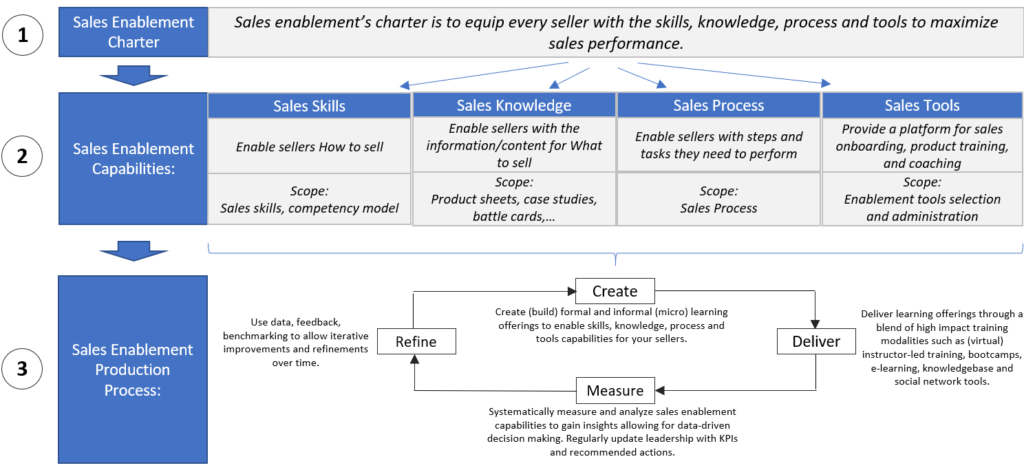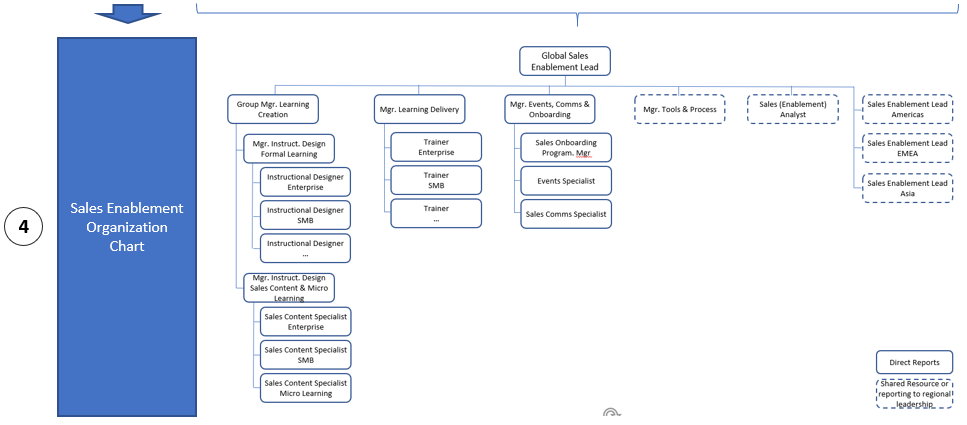Building a Capability-driven Sales Enablement Organization

Recently a professional at a fast-growing SaaS startup with about 300 sellers and 1,000 employees asked, “How would you structure a sales enablement organization?”
My first response was, “It depends.”
So, I took this question to the field. I reached out to six sales enablement and sales operations leads at similar SaaS companies in the San Francisco Bay Area and in Seattle, comparing their organization charts and adding my own wisdom from running a very large sales enablement organization at Microsoft.
What I came up with is the following suggested four-step approach and framework aimed at making life easier for anyone tasked with designing a highly scalable sales enablement organization.
Step 1: Define and agree on the charter for sales enablement.
When starting to (re)design a sales enablement organization, the first step is to identify the capabilities you want to provide your sales team – in other words, what you want them to be able to do.
To come up with the right capabilities, you will need to be clear on your sales enablement team’s charter and goals. While charters may differ somewhat between companies, the following example is a good starting place, and can be tailored according to the scope you agreed upon with your sales leadership team.
“Sales enablement’s charter is to equip every seller with the skills, knowledge, process, and tools to maximize sales performance.”
Step 2: Operationalize the charter into sales enablement capabilities.
We can derive the following capabilities from the sales enablement charter above:
- Capability 1: Sales Skills. Provide the sales team with a consistent selling approach. This should include a sales competency model to ensure that all sellers “speak the same language.”
- Capability 2: Sales Knowledge. Provide the sales team with the right information and content about the products and services we sell. If building sales skills answers the question of how we sell, knowledge answers the question of what we sell to address the needs of our customers.
- Capability 3: Sales Process. Sales processes refer to a set of steps a seller takes with a prospect to move them from early stages to closing. Forward-thinking companies go even beyond that and include all revenue-generating roles, such as marketing and customer success, into one holistic process. By doing so, consistency in definitions (for example, what is a lead?) and tasks is ensured.
- Capability 4: Sales Enablement Tools. Provide sellers with adequate training and coaching through virtual and on-demand learning. Sales enablement learning applications will help you scale onboarding and training no matter how large or dispersed your sales force. It makes your sales enablement efforts timely, trackable, and cost efficient.
Once the capabilities are agreed upon, move to the next step.
Illustration: Four Steps to Building a Capabilities-driven Sales Enablement Organization


Step 3: Get from capabilities to “sales enablement production process.”
Before we can translate the capabilities into a sales enablement organization chart, I invite you to view sales enablement as an end-to-end process. Like any (production) process, sales enablement transforms inputs and resources (e.g., money, your team) into certain outputs or services (e.g., sales training) that are then delivered (e.g., sales bootcamp).
To be efficient and productive, your sales enablement production process should measure the success of the services provided to allow for continuous refinements and improvements.
Sales enablement creates and delivers sales enablement services, measures the success of them, and continuously refines them.
Step 4: Build the sales enablement org chart.
Now we have enough information to build a sales enablement team organization chart. We need staff functions for:
- Creating formal and informal (micro) learning offerings for the four capabilities: skills, knowledge, process, and tools
- Delivering them via methods such as sales bootcamps or virtual instructor-led training
- Measuring and analyzing the outcomes
- Refining the services provided for those four capabilities based on the insights gained from the data collected
Learning creation:
- Formal training courses: All the six SaaS companies I queried had 1,000–2,000 employees and 300-400 sellers. At each company, instructional designers have created formal (structured) training for their sellers. Forward-looking companies should cover all revenue-generating roles, including, for example, customer success management. Most of them tweak and reuse their internal sales training offerings for channel partners. Many also leverage their internal subject matter experts (SMEs) to harvest their knowledge for training content.
None of the six companies made partner enablement part of the sales enablement organization. However, I know of other examples where partner enablement is part of the sales enablement organization. The reason is that they experienced misalignment and felt the best way to solve this was to combine sales and partner enablement teams under one umbrella organization. A breakdown of your customer segments such as SMB and Enterprise is strongly recommended since the sales approach and sales cycle are quite different.
- Informal learning (micro learning): Arming your sellers with knowledge and content is crucial to make them confident and competent. Most of the companies surveyed have their sales content (such as case studies, product sheets, and battle cards) created by marketing teams.
Something to look out for is that the “raw” content provided by marketing needs to be made sales-ready. Sellers do not have time to read through 20 pages of a case study. Having been in enterprise marketing myself, I know that sellers are your customers – period. They only read a case study when it helps them make a sale. So, at minimum, have at least one individual on your team work closely with marketing to ensure that all materials provided are short, crisp, and to the point while following a standardized format. Sales enablement also dictates what sales content (bill of material) is provided based on sellers’ feedback, consumption data, and sales performance.
Regarding just-in-time learning or learning in small bites – commonly referred to today as “micro learning” – none of the companies surveyed have an explicitly allocated headcount. This is a big mistake and a big opportunity at the same time. Sellers, like anyone else, learn only 10 percent of what they need to do and know through formal learning courses. Most, they learn through coaching and peer-to-peer learning. Webinars, Friday lunch best practice sharing sessions, and how-to videos are just a few examples of how to incorporate informal or micro learning. I’ve developed the following rule of thumb for deciding whether a training need will be addressed by a formal learning course or through an informal one, such as webinar or presentation:
By default, any training request will be an informal learning request unless the business need is critical and the shelf life of the learning asset is longer than six months.
Learning delivery:
As instructional designers are focusing on designing and creating training and sales content, learning delivery (as the name suggests) is tasked with delivering the training and content to sellers. This can be an in-person training, virtually (live or on-demand), or straight being posted to the sales enablement/learning portal. The various types of training delivery are also referred to as “training modalities.” In several instances of the companies analyzed, the trainer could be the SME who created the learning asset in the first place.
Events, communications and sales onboarding:
It makes sense to bundle sales onboarding, sales kick-offs, and communications under one umbrella. Very few of the companies compared have dedicated communications resources to ensure that sellers are regularly updated when new training, webinars, customer pitch decks, new price lists, etc., are available and delivered through a weekly enablement newsletter. However, marketing is important to land your enablement initiatives and activities – especially if you have a fast-growing sales team spread across geographies.
Tools and processes:
Sales enablement is as much about people as it is about technology and process – especially when your company grows fast. The right set of tools and processes build the foundation to scale with less growing pains.
Sales operations and sales enablement need to work hand in hand when it comes to tools and processes.
For example, sales ops is tasked with sales forecasting while sales enablement is tasked with how to complete sales forecasting well. Several of the companies analyzed have a dedicated resource or share a resource when it comes to sales enablement tools and apps to ensure that the tools used are compatible and data is easily transferrable for reporting and analysis.
Sales enablement analyst:
Over the past few years, there has been a big push to use data and insights to systematically understand what sales enablement activities have the biggest impact on driving sales performance, as well as determine the root causes of inferior sales performance to thus create training and content to address those issues.
Surprisingly, only one of the six companies compared is using data as a critical instrument to drive sales (enablement) performance. The use of data is a very powerful instrument in proving the value of your organization and justifying the ROI of certain resources you request.
I am speaking from my own experience. At a minimum, you start analyzing what sales content assets are being used by your sellers (consumption data), having your sellers rate any training they take and content they use. Then, create some Key Performance Indicators (KPIs) to measure items such as ramp-up time, training, and content metrics. Finally, use key sales metrics such as quota attainment and win rates to analyze how you can move the needle by either working on sales competencies or improving your portfolio of sales content. Internalize that sales enablement is not a means to an end but is intended to drive sales performance and results. As far as I am concerned, your sales enablement org needs to include an analyst, even if it is a shared resource with sales operations.
Regional sales enablement leads:
Once your company starts to expand into other geographies, you should think about how to enable sellers in the new region or country (e.g., Europe or Asia). It is important for someone to take on this role if a dedicated resource cannot be afforded. This can be the regional sales leader or a contractor – and, eventually, a full-time resource. In terms of reporting structure, they might either report to the regional sales leadership or directly to the global sales enablement lead. Only two of the companies surveyed had regional leads included in their org chart.
Conclusion
The four-step approach outlined should provide a good start to building and developing a sales enablement organization. Of course, this overview is just a foundation – there are many other topics to address, including who creates the sales playbook and where this should occur.
I invite your feedback and questions on this approach.
This article was a collaboration that included valuable input from Courtney A. Skay and Andrea Ihara.
Get our eNewsletter
Get the latest sales leadership insight, strategies, and best practices delivered weekly to your inbox.
Sign up NOW →